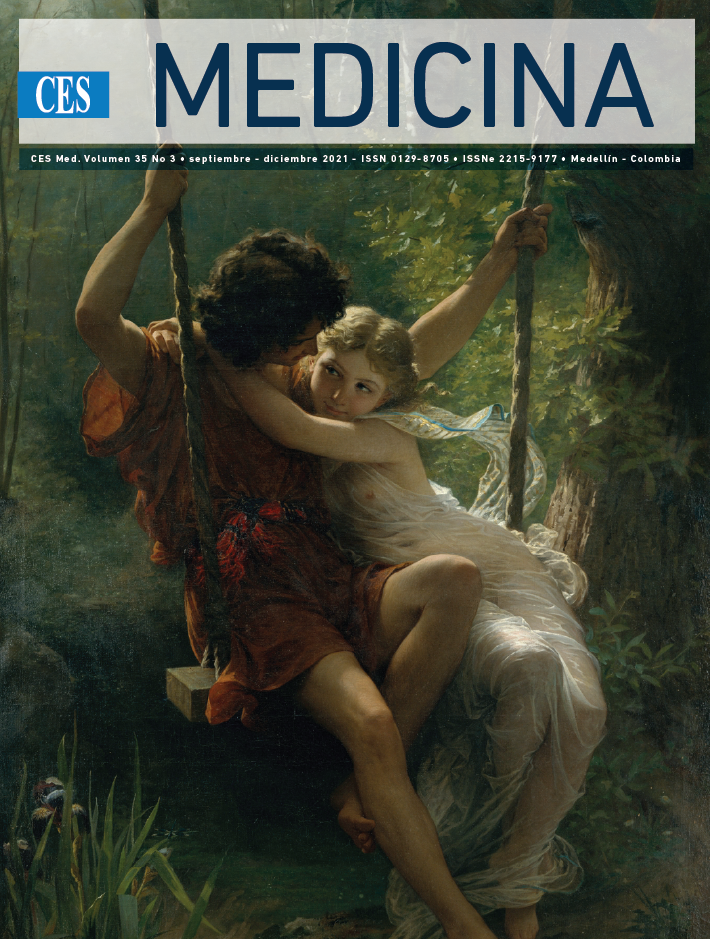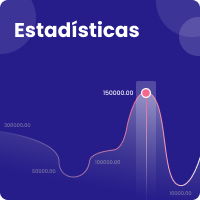Cardiomiopatía hipertrófica en fase de burnout
DOI:
https://doi.org/10.21615/cesmedicina.6244Palabras clave:
cardiomiopatía hipertrófica, fase burnout, estudio de caso, imagen por resonancia magnética, fibrilación auricularResumen
La cardiomiopatía hipertrófica es una entidad de origen genético que se caracteriza por hipertrofia ventricular izquierda en ausencia de otras enfermedades como etiología. Los pacientes suelen ser asintomáticos; sin embargo, el espectro de presentación es amplio pudiéndose encontrar falla cardiaca, obstrucción del tracto de salida, arritmias, muerte súbita y la etapa final o ''burnout''. La valoración morfológica inicial se realiza con ecocardiograma transtorácico, aunque la resonancia magnética cardiaca es el estudio de elección para confirmar el diagnóstico. Presentamos el caso de una mujer de 43 años con antecedente de cardiomiopatía hipertrófica quien había sido intervenida previamente e ingresó al servicio de urgencias de forma descompensada, documentándose progresión a fase “burnout” y su manejo subsecuente. Si bien este fenotipo no es común tiene importantes implicaciones pronósticas y en la calidad de vida. Por lo anterior, un diagnóstico y tratamiento oportuno pueden impactar favorablemente.
Descargas
Referencias bibliográficas
Antunes M de O, Scudeler TL. Hypertrophic cardiomyopathy. IJC Hear Vasc. 2020;27:100503.
Teekakirikul P, Zhu W, Huang HC, Fung E. Hypertrophic cardiomyopathy: An overview of genetics and management. Biomolecules. 2019;9(12):1–11.
Maron BJ. Clinical Course and Management of Hypertrophic Cardiomyopathy. N Engl J Med. 2018;379(7):655–68.
Brinkley DM, Wells QS, Stevenson LW. Avoiding Burnout from hypertrophic cardiomyopathy. J Am Coll Cardiol. 2020;75(24):3044-3047. doi: 10.1016/j.jacc.2020.05.009. PMID: 32553257.
Ommen SR, Mital S, Burke MA, Day SM, Deswal A, Elliott P, et al. 2020 AHA/ACC Guideline for the diagnosis and treatment of patients with hypertrophic cardiomyopathy: executive summary: A report of the American College of Cardiology/American Heart Association Joint Committee on Clinical Practice Guidelines. Circulation. 2020;533–57.
Maron MS, Rowin EJ, Maron BJ. How to image hypertrophic cardiomyopathy. Circ Cardiovasc Imaging. 2017;10(7):1–15.
Abad P, Asociacion Colombiana de Radiologia. Miocardiopatías. Dr. Pedro Abad Díaz - Conferencia Virtual [Internet]. Colombia: Asociacion Colombiana de Radiologia; 2018. Available from: http://www.acronline.org/ACR-Admin/NOTI-CCR/ArtMID/1061/ArticleID/5966/Miocardiopat237as-Dr-Pedro-Abad-D237az-Conferencia-Virtual
Heitner SB, Jacoby D, Lester SJ, Owens A, Wang A, Zhang D, et al. Mavacamten treatment for obstructive hypertrophic cardiomyopathy a clinical trial. Ann Intern Med. 2019;170(11):741–8.
Zhang YP, He B. Mavacamten: a promising new target drug for the treatment of hypertrophic cardiomyopathy. Zhonghua Xin Xue Guan Bing Za Zhi [Internet]. 2021 Apr 24;49(4):310–3. Available from: http://www.ncbi.nlm.nih.gov/pubmed/33874678
Olivotto I, Oreziak A, Barriales-Villa R, Abraham TP, Masri A, Garcia-Pavia P, et al. Mavacamten for treatment of symptomatic obstructive hypertrophic cardiomyopathy (EXPLORER-HCM): a randomised, double-blind, placebo-controlled, phase 3 trial. Lancet [Internet]. 2020;396(10253):759–69. Available from: https://linkinghub.elsevier.com/retrieve/pii/S014067362031792X
Tower-Rader A, Ramchand J, Nissen SE, Desai MY. Mavacamten: a novel small molecule modulator of β-cardiac myosin for treatment of hypertrophic cardiomyopathy. Expert Opin Investig Drugs [Internet]. 2020;29(11):1171–8. Available from: https://www.tandfonline.com/doi/full/10.1080/13543784.2020.1821361
Ho CY, Mealiffe ME, Bach RG, Bhattacharya M, Choudhury L, Edelberg JM, et al. Evaluation of Mavacamten in symptomatic patients with nonobstructive hypertrophic cardiomyopathy. J Am Coll Cardiol [Internet]. 2020;75(21):2649–60. Available from: https://linkinghub.elsevier.com/retrieve/pii/S0735109720348567
Cooper RM, Raphael CE, Liebregts M, Anavekar NS, Veselka J. New developments in hypertrophic cardiomyopathy. Can J Cardiol [Internet]. 2017;33(10):1254–65. Available from: https://linkinghub.elsevier.com/retrieve/pii/S0828282X17303719
Nishimura RA, Seggewiss H, Schaff H V. Hypertrophic obstructive cardiomyopathy: Surgical myectomy and septal ablation. Circ Res. 2017;121(7):771–83.
Solomon Z, Breton C, Rowin EJ, Maron BJ, Maron MS, Chen FY, et al. Surgical Approaches to hypertrophic obstructive cardiomyopathy. Semin Thorac Cardiovasc Surg. 2018;30(2):125–8.
O’Neill L, Duytschaever M, Knecht S. Atrial fibrillation ablation in patients with hypertrophic cardiomyopathy: do not throw in the towel too fast! Europace [Internet]. 2021; Available from: http://www.ncbi.nlm.nih.gov/pubmed/33930128
Ali A. Atrial Fibrillation in Hypertrophic Cardiomyopathy: Diagnosis and Considerations for Management. J Atr Fibrillation [Internet]. 2018;10(5). Available from: http://www.jafib.com/published.php?type=full&id=1556
Santangeli P, Di Biase L, Themistoclakis S, Raviele A, Schweikert RA, Lakkireddy D, et al. Catheter Ablation of atrial fibrillation in hypertrophic cardiomyopathy. circ arrhythmia electrophysiology [Internet]. 2013;6(6):1089–94. Available from: https://www.ahajournals.org/doi/10.1161/CIRCEP.113.000339
Cui H, Schaff H V., Dearani JA, Lahr BD, Viehman JK, Geske JB, et al. Does ablation of atrial fibrillation at the time of septal myectomy improve survival of patients with obstructive hypertrophic cardiomyopathy? J Thorac Cardiovasc Surg [Internet]. 2021;161(3):997-1006.e3. Available from: https://linkinghub.elsevier.com/retrieve/pii/S0022522320324545
Bogachev-Prokophiev A V., Afanasyev A V., Zheleznev SI, Pivkin AN, Fomenko MS, Sharifulin RM, et al. Concomitant ablation for atrial fibrillation during septal myectomy in patients with hypertrophic obstructive cardiomyopathy. J Thorac Cardiovasc Surg [Internet]. 2018;155(4):1536-1542.e2. Available from: https://linkinghub.elsevier.com/retrieve/pii/S0022522317318251
Caldeira D, Lopes LR, Cruz I, Almeida AR, Morgado G, Gomes C, Stuart B, Almeida S, Brandão L, Pereira H. The burnout stage of an apical hypertrophic cardiomyopathy. Int J Cardiol. 2014;177(3):e179-80. doi: 10.1016/j.ijcard.2014.08.092. Epub 2014 Aug 23. PMID: 25179554.
Rowin EJ, Maron BJ, Abt P, Kiernan MS, Vest A, Costantino F, et al. Impact of Advanced therapies for improving survival to heart transplant in patients with hypertrophic cardiomyopathy. Am J Cardiol. 2018;121(8):986–96.
Descargas
Publicado
Cómo citar
Número
Sección
Licencia
Derechos de autor 2021 CES Medicina

Esta obra está bajo una licencia internacional Creative Commons Atribución-NoComercial-CompartirIgual 4.0.
Derechos de reproducción (copyright)
Cada manuscrito se acompañará de una declaración en la que se especifique que los materiales son inéditos, que no han sido publicados anteriormente en formato impreso o electrónico y que no se presentarán a ningún otro medio antes de conocer la decisión de la revista. En todo caso, cualquier publicación anterior, sea en forma impresa o electrónica, deberá darse a conocer a la redacción por escrito.
Plagios, duplicaciones totales o parciales, traduccones del original a otro idioma son de responsabilidad exclusiva de los autores el envío.
Los autores adjuntarán una declaración firmada indicando que, si el manuscrito se acepta para su publicación, los derechos de reproducción son propiedad exclusiva de la Revista CES Medicina.
Se solicita a los autores que proporcionen la información completa acerca de cualquier beca o subvención recibida de una entidad comercial u otro grupo con intereses privados, u otro organismo, para costear parcial o totalmente el trabajo en que se basa el artículo.
Los autores tienen la responsabilidad de obtener los permisos necesarios para reproducir cualquier material protegido por derechos de reproducción. El manuscrito se acompañará de la carta original que otorgue ese permiso y en ella debe especificarse con exactitud el número del cuadro o figura o el texto exacto que se citará y cómo se usará, así como la referencia bibliográfica completa.
| Estadísticas de artículo | |
|---|---|
| Vistas de resúmenes | |
| Vistas de PDF | |
| Descargas de PDF | |
| Vistas de HTML | |
| Otras vistas | |



